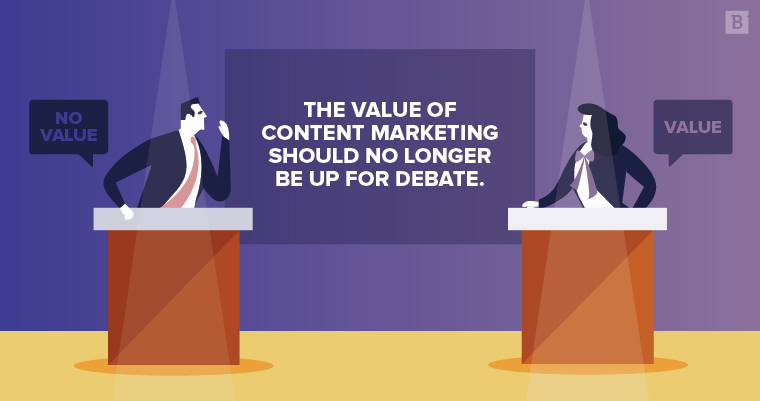Content marketing works. There, I said it.
But that’s what everyone has been saying the last decade. So why is it that marketers are still in the position of having to convince their superiors, their colleagues and the world at large of the value of content marketing?
That’s to say nothing of the awkward conversation around the holiday dinner table when you try to explain what content marketing is to your parents. “You know all the words on the internet? Yeah, I write those,” is usually my default response.
Content Writer Awkwardly Shows Parents Around Website Where He Works http://t.co/xkiYZ1H1PS pic.twitter.com/JuiTQiPWjg
— The Onion (@TheOnion) April 24, 2015
We’ve compiled three examples that prove the value of content marketing as well as the terms, metrics and content formats you should be familiar with. So if anyone ever badgers you about proof, you know where to send them.
The value of content marketing in action: 3 examples
Without further ado, take a look at how Brafton has recently registered some big wins for our clients. (Click here for dozens of more success stories.)
1. How Brafton helped USC Consulting Group land a $1 million deal
If it’s not revenue your boss is hoping to see out of your content marketing efforts, then we feel sorry about your business model.
Beginning in 2015, USC Consulting Group has partnered with Brafton to support their small marketing team, produce blogs, case studies, video and populate their site with top-notch content.
In one instance, an eBook we wrote was circulated to USC’s email subscribers. One prospect was so impressed, he asked to see case studies to ensure he wasn’t dealing with a too-good-to-be-true vendor.
After coming away convinced that USC was the real deal, the prospect signed a $1 million deal – it all started with an eBook. You couldn’t build a better content marketing supply chain if you tried.
Actionable takeaways for your brand
- You need bottom-of-funnel assets to help close deals. In this case, eBooks and case studies did the job.
- Nurturing prospects with additional content is a must. If you don’t have an arsenal of targeted, high-intent content at the ready, you’re missing out on business opportunities.
- Content serves a purpose at every point in the funnel, so invest accordingly.
2. CloudSmartz drives brand awareness and qualified leads with Brafton
Content marketing often overlaps with sales. But at the core of each is the business goal of converting leads and closing deals. That’s exactly how Brafton’s proprietary landing page and optimization services helped CloudSmartz, a software engineering firm.
For more than two years, CloudSmartz leveraged its Brafton-produced blog posts, infographics, videos, white papers and eBooks to generate brand awareness and target prospects at industry trade shows.
In 2016, CloudSmartz was hoping to secure 12 meetings after a conference. Brafton’s lead-gen technology was able to bump that number to 18 meetings.
One year later, that same conference resulted in 25 meetings.
Now that’s how you set your sales team up for success.
Actionable takeaways for your brand
- Marketing and sales must be aligned on a singular goal, and it should be clear what that goal is throughout the content.
- Content that doesn’t convert (or lead to a conversion) is much less valuable to the bottom line.
- Sales prospects need contents of all types, for both digital and physical touchpoints.
3. Carey International takes the fast lane to social media success
Content is often only as good as the platforms it’s shared on. And for most marketers, social media is the primary publishing outlet for sharing and promoting their content.
That’s why having not just social followers but engaged social followers is paramount to content marketing success.
Carey International quickly recognized this after partnering with Brafton. Within two weeks, Brafton’s social media strategist had perfected Carey International’s brand voice. Over a nine-month period of sharing Brafton-created content on Twitter and Facebook, Carey International’s followers jumped 24.8 and 20.4 percent, respectively.
Better yet, engagement on these channels skyrocketed 1,357 and 329.5 percent.
All of this equated to more impressions, more prospects and more contacts.
Actionable takeaways for your brand
- Content creation is half the battle – content promotion is just as important.
- Social media success is not achievable without original, thought-provoking content.
- Updated social profiles keep customers and prospects informed on your brand.
Content marketing vs. traditional marketing: Which produces higher ROI?
Content marketing is by definition an inbound digital strategy. Instead of cold calls, trade shows, TV ads, print spreads and overly promotional product-pushing (outbound/traditional marketing), content marketing uses tactics that pull in customers who want to know more about you.
After coming away convinced that USC was the real deal, the prospect signed a $1 million deal – it all started with an eBook. You couldn’t build a better content marketing supply chain if you tried.
Outbound messaging is more expensive and narrow-minded in its scope. Inbound messaging, however, relies on native, nondisruptive drips of information that consumers find engaging and thought-provoking – there’s no hard sales pitch.
Compared to traditional marketing, consider:
- Content marketing delivers 3X the number of leads.
- Content marketing costs 62 percent less.
- Content marketing converts 6X as many leads.
It’s simple math: Content marketing produces higher ROI.
The value of content marketing: Beyond dollar signs
It’s easy to associate “value” specifically with “revenue.” This is fine but also a tad misleading insofar as “value” extends beyond just dollar signs.
The branding impact alone is often immeasurable, so let’s look at some of the ways to assess “value” without referring to only money. Your boss is going to want to know this information as well.
Immediate value
- Complete control of messaging and branding.
- Credibility and relevance in online communities.
- Longer content shelf life.
- Targeted buyer personas.
- More search engine-indexed pages.
- Local SEO wins.
Long-term value
- Stronger, two-way conversations with customers.
- Word-of-mouth referrals.
- Search engine dominance.
- Sales and marketing alignment.
- Consistency and industry authority.
- Stronger link equity.
- Multipurpose content repository.
- Enhanced market perception.
How to prove the value of content marketing to your boss
In terms of showing your boss progress, you’ll need every metric and indicator at your disposal. Plus, you’ll need a strong pitch, as sometimes the pitch is what’s actually standing in your way of getting the executive buy-in for additional investments into content marketing.
Here are some metrics-reporting and expectation-setting tips for you to use:
Macro goals: Bottom-of-funnel actions that directly impact your bottom line:
- Purchases from site.
- Demo requests.
- Contact with sales team.
Micro goals: Top-of-funnel actions that indirectly impact your bottom line:
- Downloads of gated assets.
- Backlinks to site.
- Social shares.
- Newsletter subscriptions.

Be careful about resting on your laurels, however, as not all metrics correlate directly to ROI. We consider these to be vanity metrics, which are great on paper but mean little in the way of what matters. Those include:
- Bounce rate.
- Pages per session.
- Organic traffic.
- Time on site.
If your boss isn’t marketing savvy, you’ll likely be speaking to a brick wall by using every piece of jargon under the moon. Instead, adjust your language to match what your boss understands and to what his or her goals are.
This likely means pitching content marketing as a way to:
- Expedite the sales process.
- Better understand prospects.
- Improve customer retention.
- Qualify sales-ready leads.
- Support upsell opportunities.
- Reduce costs associated with traditional marketing (e.g., cold calls).
Your boss may then ascertain exactly where your head’s at and whether it’s an investment he or she is willing to make.
Content that converts in 2018
To ensure you’ve done all you can to prove the value of content marketing, it’s important to fully grasp the content formats that are primed to succeed in 2018.

- Blog posts: Long-form blogs produce 9X more leads than short-form.
- User-generated content: 50 percent reduction in CPC compared to regular content.
- Social posts: Social media is the second most used content tactic, behind blogging.
- Case studies: The most successful asset for 88 percent of B2B marketers.
- eBooks: 63 percent of buyers will submit their personal information for an eBook.
- White papers: 76 percent of buyers will submit their personal information for a white paper.
- Landing pages: 86 percent increase in conversions when LPs contain videos.
- Infographics: 12 percent increase in conversions when companies use infographics.
- Videos: 74 percent of all internet traffic is video content.
Any other information you’re still hurting to find out? Let us know.
And if your boss still isn’t sold on the value of content marketing, we’ll gladly hop on the phone to sort things out.






